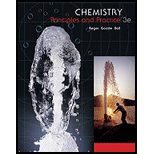
Concept explainers
(a)
Interpretation:
The liquid that is expected to have greater enthalpy of vaporization has to be given.
Concept Introduction:
Intermolecular forces: Intermolecular forces are electrostatic in nature and include van der Waals forces and hydrogen bonds. Molecules in liquids are held to other molecules by intermolecular interactions, which are weaker than the intramolecular interactions that hold the atoms together within molecules and polyatomic ions. The three major types of intermolecular interactions are,
- Dipole-dipole interactions
- London dispersion forces
- Hydrogen bonds
(a)
Answer to Problem 11.56QE
The enthalpy of vaporization is expected to be greater for ethylene
Explanation of Solution
Both ethylene
(b)
Interpretation:
The liquid that is expected to have greater enthalpy of vaporization has to be given.
Concept Introduction:
Refer to part (a).
(b)
Answer to Problem 11.56QE
The enthalpy of vaporization is expected to be greater for chlorine
Explanation of Solution
Chlorine has London dispersion force and
(c)
Interpretation:
The liquid that is expected to have greater enthalpy of vaporization has to be given.
Concept Introduction:
Refer to part (a).
(c)
Answer to Problem 11.56QE
The enthalpy of vaporization is expected to be greater for
Explanation of Solution
Both
(d)
Interpretation:
The liquid that is expected to have greater enthalpy of vaporization has to be given.
Concept Introduction:
Refer to part (a).
(d)
Answer to Problem 11.56QE
The enthalpy of vaporization is expected to be greater for
Explanation of Solution
The intermolecular force present in ammonia is hydrogen bonding and the intermolecular force present in phosphine is dipole-dipole attraction/London dispersion force. The enthalpy of vaporization of liquid depends on its boiling point. The boiling point of ammonia is said to be greater. Stronger the intermolecular force, higher the boiling point, greater will be the enthalpy of vaporization. Therefore, the enthalpy of vaporization of ammonia would greater than phosphine.
(e)
Interpretation:
The liquid that is expected to have greater enthalpy of vaporization has to be given.
Concept Introduction:
Refer to part (a).
(e)
Answer to Problem 11.56QE
The enthalpy of vaporization is expected to be greater for
Explanation of Solution
Both methyl iodide
(f)
Interpretation:
The liquid that is expected to have greater enthalpy of vaporization has to be given.
Concept Introduction:
Refer to part (a).
(f)
Answer to Problem 11.56QE
The enthalpy of vaporization is expected to be greater for
Explanation of Solution
Both
Want to see more full solutions like this?
Chapter 11 Solutions
Chemistry
- Dichloromethane, CH2Cl2,is widely used as a degreaser and paint stripper. Its vapor pressure is 381.0 mm Hg at 21.9C and 465.8 mm Hg at 26.90C. Estimate (a) its heat of vaporization (Hvap). (b) its normal boiling point.arrow_forwardThe heats of vaporization of liquid O2, liquid Ne, and liquid methanol, CH3OH, are 6.8 kJ/moL 1.8 kJ/mol, and 34.5 kJ/mol, respectively. Are the relative values as you would expect? Explain.arrow_forwardhe enthalpy (H)of vaporization of water is about seven times larger than water’s enthalpy fusion(41kJ/molvs.6kJ/mol). What does this tell us about the relative similarities among the solid, liquid, and gaseous states of water?arrow_forward
- Chloroform, CHCl3, a volatile liquid, was once used as an anesthetic but has been replaced by safer compounds. Chloroform boils at 61.7C and has a heat of vaporization of 31.4 kJ/mol. What is its vapor pressure at 37.2C?arrow_forwardOf the four general types of solids, which one(s) (a) are generally insoluble in water? (b) have very high melting points? (c) conduct electricity as solids?arrow_forwardDiethyl ether (CH3CH2OCH2CH3) was one of the first chemicals used as an anesthetic. At 34.6C, diethyl ether has a vapor pressure of 760. torr, and at 17.9C, it has a vapor pressure of 400. torr. What is the H of vaporization for diethyl ether?arrow_forward
- p-Dichlorobenzene, C6H4Cl2, can be one of the ingredients in mothballs. Its vapor pressure at 20C is 0.40 mm Hg. (a) How many milligrams of C6H4Cl2 will sublime into an evacuated 750-mL flask at 20C? (b) If 5.0 mg of p-dichlorobenzene were put into an evacuated 750-mL flask, how many milligrams would remain in the solid phase? (c) What is the final pressure in an evacuated 500-mL flask at 20C that contains 2.00 mg of p-dichlorobenzene? Will there be any solid in the flask?arrow_forwardTrichloroethane, C2H3Cl3, is the active ingredient in aerosols that claim to stain-proof men's ties. Trichloroethane has a vapor pressure of 100.0 mm Hg at 20.0C and boils at 74.1C. An uncovered cup (12pint) of trichloroethane (d=1.325g/mL) is kept in an 18-ft3 refrigerator at 39F. What percentage (by mass) of the trichloroethane is left as a liquid when equilibrium is established?arrow_forwardWhat is U when 1.00 mol of liquid water vaporizes at 100C? The heat of vaporization, Hvap, of water at 100C is 40.66 kJ/mol.arrow_forward
 Chemistry: Principles and PracticeChemistryISBN:9780534420123Author:Daniel L. Reger, Scott R. Goode, David W. Ball, Edward MercerPublisher:Cengage Learning
Chemistry: Principles and PracticeChemistryISBN:9780534420123Author:Daniel L. Reger, Scott R. Goode, David W. Ball, Edward MercerPublisher:Cengage Learning General Chemistry - Standalone book (MindTap Cour...ChemistryISBN:9781305580343Author:Steven D. Gammon, Ebbing, Darrell Ebbing, Steven D., Darrell; Gammon, Darrell Ebbing; Steven D. Gammon, Darrell D.; Gammon, Ebbing; Steven D. Gammon; DarrellPublisher:Cengage Learning
General Chemistry - Standalone book (MindTap Cour...ChemistryISBN:9781305580343Author:Steven D. Gammon, Ebbing, Darrell Ebbing, Steven D., Darrell; Gammon, Darrell Ebbing; Steven D. Gammon, Darrell D.; Gammon, Ebbing; Steven D. Gammon; DarrellPublisher:Cengage Learning
 ChemistryChemistryISBN:9781305957404Author:Steven S. Zumdahl, Susan A. Zumdahl, Donald J. DeCostePublisher:Cengage Learning
ChemistryChemistryISBN:9781305957404Author:Steven S. Zumdahl, Susan A. Zumdahl, Donald J. DeCostePublisher:Cengage Learning Chemistry: An Atoms First ApproachChemistryISBN:9781305079243Author:Steven S. Zumdahl, Susan A. ZumdahlPublisher:Cengage Learning
Chemistry: An Atoms First ApproachChemistryISBN:9781305079243Author:Steven S. Zumdahl, Susan A. ZumdahlPublisher:Cengage Learning Chemistry: Principles and ReactionsChemistryISBN:9781305079373Author:William L. Masterton, Cecile N. HurleyPublisher:Cengage Learning
Chemistry: Principles and ReactionsChemistryISBN:9781305079373Author:William L. Masterton, Cecile N. HurleyPublisher:Cengage Learning





